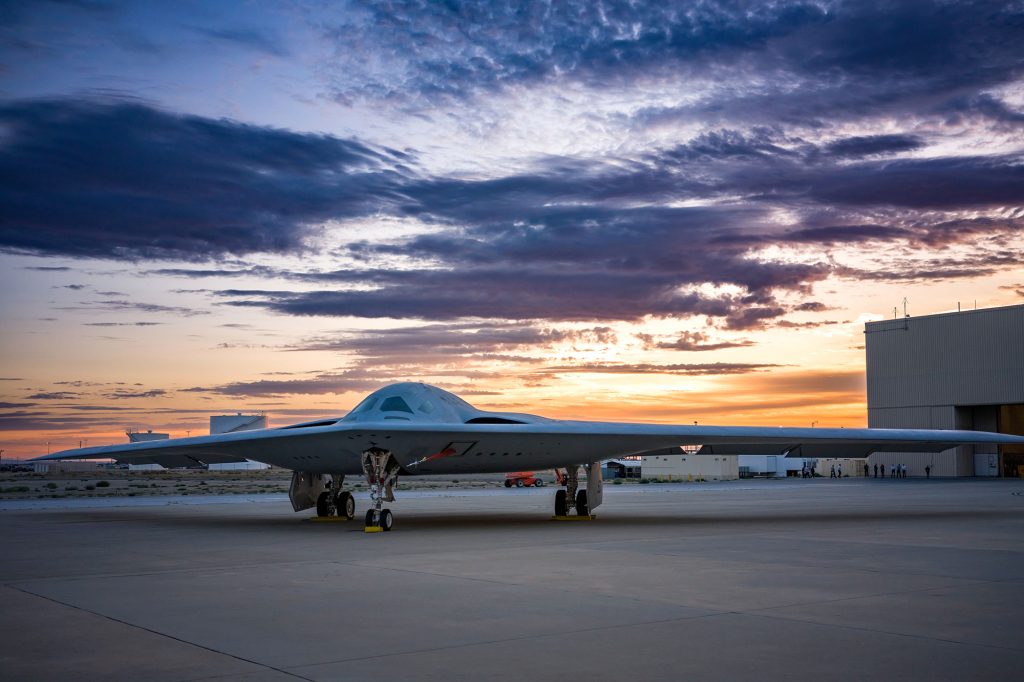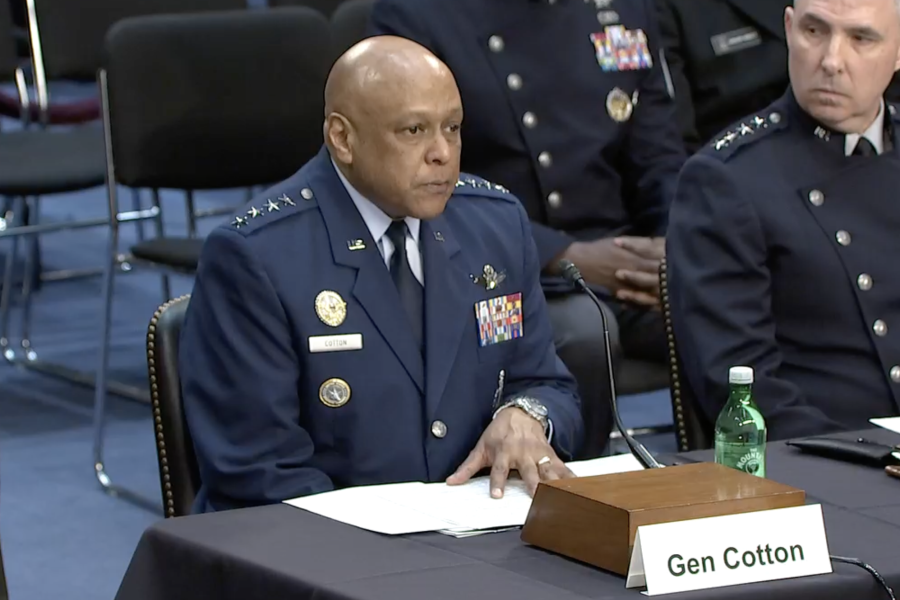The head of U.S. Strategic Command stressed the importance of producing B-21 bombers at a quicker rate and expressed interest in acquiring more than the planned 100 aircraft in a Senate Armed Services Committee hearing Feb. 29.
“The limited production rate of the B-21 is the only thing that I wish we could do a little quicker,” Gen. Anthony J. Cotton told Sen. Tom Cotton (R-Ark.). “The fact that that is an incredible sixth-generation platform, all indications are that the weapons system is moving along at a great pace as far as delivery. The ability for production and the number of production, as a warfighter, obviously I would love more.”
“It’d be nice to have more than 100,” Sen. Cotton added.
“Yes sir,” Gen. Cotton replied.
The stealthy B-21 is slated to replace the Air Force’s B-1 Lancers and B-2 Spirits as the fleet’s long-range bomber. The Pentagon has said it wants to buy at least 100 Raiders. Each is expected to cost more than $500 million, with deliveries starting in the mid-2020s. The bomber had its first flight Nov. 10 from Air Force Plant 42 in Palmdale, Calif, and has had subsequent test flights at Edwards Air Force Base.
In addition to the first bomber, the service has acknowledged that five more aircraft are in some stage of construction at Plant 42, and that at least five of the six B-21s will be dedicated to test activities. After developmental and operational testing is complete, those aircraft will have their test instrumentation removed and be modified into operational bombers.
Various think tanks, including the Mitchell Institute for Aerospace Studies, and former heads of Global Strike Command have called for as many as 150-225 B-21s to maintain the pace of operations necessary to successfully conduct a war with a near-peer adversary like China.
Cotton did not specify how many more B-21s he would like to see produced.

In addition to the B-21, Cotton also underscored the importance of the B-52‘s upgrade to nuclear modernization, highlighting the bomber’s capability to carry new Long-Range Standoff missiles.
“As we look at what the capacity and what the capability is of that weapon system, that platform, it’s amazing.” Cotton stated. “We need to think about the ability for it to carry LRSO, it is the platform that has a lot of mass as far as capability. And I want it to be able to have a long-range strike standoff capability even greater than it has.”
The Air Force plans to upgrade the B-52’s engines, radar, and more in the late 2020s or early 2030s. This upgrade is expected to provide increased thrust and fuel efficiency, enabling the jet to fly faster and farther, while enhancing reliability and extending the fleet’s service life.
While Cotton told lawmakers the U.S. currently holds superiority in its nuclear arsenal, he acknowledged that if China maintains its current pace of development as projected by the Pentagon, they could achieve parity with the U.S. in the realm of land-based systems by 2035. In that timeframe, the combined nuclear weapons count of Russia and China would surpass that of the U.S., according to Cotton.
He also emphasized the importance of upgrading the Air Force’s current Minuteman III intercontinental ballistic missiles with the new Sentinel program, which came under scrutiny from Sen. Elizabeth Warren (D-Mass.).
Last month, the Air Force revealed that the Sentinel program will cost 37 percent more and take at least two years longer to achieve initial operational capability than previously projected. The original program estimate of $95 billion jumped to $132 billion, raising concerns amongst lawmakers and triggering a mandatory review of the program’s viability.
Warren says she is “glad” about the review but argued the Pentagon needs a separate review by independent experts “who will ask hard questions” about the program. Asked if he agreed with the suggestion, Cotton merely said he cannot endure a gap or drop in the reliability of a current platform.
“I’ll be watching closely to see if the DOD takes this review that is required now by law because of the cost overruns,” Warren said. “I will be looking to see if they take this review seriously, or if it’s just another paperwork exercise to justify throwing more money at more expensive nuclear programs.”
Air Force Secretary Frank Kendall has said discussions on how to cover Sentinel’s cost overrun haven’t occurred yet, but he has argued there is no alternative to Sentinel or any other program in the Air Force’s nuclear modernization, a sentiment echoed by Cotton.
“There is no change in the requirements that I currently have on the modernization of all three legs of the triad,” Cotton said. “That absolutely has to be done.”
Last week, Russian President Vladimir Putin stated that 95 percent of Russia’s strategic nuclear forces have been modernized. China is surpassing the United States and its number of fixed ICBM launchers, according to Cotton. He also pointed out the significance of missile developments in North Korea and Iran’s nuclear ambitions, and the growing ties among these nations, adding complexity to the landscape.
“While our legacy systems continue to hold potential adversaries at risk, it is absolutely critical we continue at speed with the modernization of our nuclear triad, including land-based ICBMs, the B-21, the B-52, the Columbia-class submarine, the nuclear sea-launched cruise missile, and LRSO, as well as numerous related systems,” Cotton said. “We do this in the face of challenges unlike anything America has ever encountered.”


